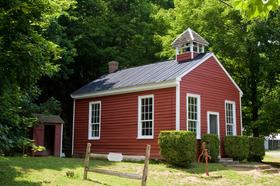Serving 481 students in grades Prekindergarten-1, Ft Sanders Education Development Center ranks in the bottom 50% of all schools in Tennessee for overall test scores (math proficiency is bottom 50%, and reading proficiency is top 50%).
The percentage of students achieving proficiency in math is ≥50% (which is lower than the Tennessee state average of 52%). The percentage of students achieving proficiency in reading/language arts is ≥50% (which is lower than the Tennessee state average of 51%).
Minority enrollment is 35% of the student body (majority Black), which is lower than the Tennessee state average of 43% (majority Black).
Quick Stats (2025)
- School Type: Special education school
- Grades: Prekindergarten-1
- Enrollment: 481 students
- Minority Enrollment: 35%
- Math Proficiency: ≥50%
- Reading Proficiency: ≥50%
- Source: National Center for Education Statistics (NCES), TN Dept. of Education
School Overview
Ft Sanders Education Development Center's student population of 481 students has grown by 63% over five school years.
The teacher population of 9 teachers has declined by 30% over five school years.
School Type
Grades Offered
Grades Prekindergarten-1
(No virtual instruction)
(No virtual instruction)
Total Students
481 students
Gender %
Total Classroom Teachers
9 teachers
School Rankings
The diversity score of Ft Sanders Education Development Center is 0.54, which is less than the diversity score at state average of 0.61. The school's diversity has stayed relatively flat over five school years.
Math Test Scores (% Proficient)
(13-14)≥50%
52%
Reading/Language Arts Test Scores (% Proficient)
(14-15)≥50%
51%
Student : Teacher Ratio
n/a
15:1
American Indian
1%
n/a
Asian
4%
2%
Hispanic
10%
15%
Black
18%
21%
White
65%
57%
Hawaiian
n/a
n/a
Two or more races
2%
5%
All Ethnic Groups
Participates in the National School Lunch Program (NSLP)
Yes
Eligible for Free Lunch
6%
45%
Eligible for Reduced Lunch
1%
6%
School Statewide Testing
School District Name
Source: National Center for Education Statistics (NCES), TN Dept. of Education
Profile last updated: 02/09/2025
Frequently Asked Questions
What schools are Ft Sanders Education Development Center often compared to?
Ft Sanders Education Development Centeris often viewed alongside schools like Fair Garden Family/community Center, Knox Adaptive Education Center by visitors of our site.
What percent of students have achieved state testing proficiency in math and reading?
≥50% of students have achieved math proficiency (compared to the 52% TN state average), while ≥50% of students have achieved reading proficiency (compared to the 51% TN state average).
How many students attend Ft Sanders Education Development Center?
481 students attend Ft Sanders Education Development Center.
What is the racial composition of the student body?
65% of Ft Sanders Education Development Center students are White, 18% of students are Black, 10% of students are Hispanic, 4% of students are Asian, 2% of students are Two or more races, and 1% of students are American Indian.
What grades does Ft Sanders Education Development Center offer ?
Ft Sanders Education Development Center offers enrollment in grades Prekindergarten-1 (No virtual instruction).
What school district is Ft Sanders Education Development Center part of?
Ft Sanders Education Development Center is part of Knox County School District.
In what neighborhood is Ft Sanders Education Development Center located?
Ft Sanders Education Development Center is located in the Fort Sanders neighborhood of Knoxville, TN.
School Reviews
Review Ft Sanders Education Development Center. Reviews should be a few sentences in length. Please include any comments on:
- Quality of academic programs, teachers, and facilities
- Availability of music, art, sports and other extracurricular activities
Recent Articles

Segregation in K-12 Education: Colonial Era
Explore the origins of educational segregation during the colonial era and the differential treatment of Native American, African American, and white students. This article delves into the historical context, policies, and societal attitudes that shaped early education in colonial America, highlighting the disparities and injustices that persisted within the schooling systems of that time.

2011 Classroom Size Update: Are Classes Still Growing Larger?
Since the recession, public school classrooms have seen major budget cuts - and many increases in class sizes. How is the situation in 2011? Read this article to find out.

Will Single Sex Classrooms Save ╬█╬█┬■╗ş Schools?
Learn about the benefits of single sex classrooms and why public schools are hoping this type of classroom will save the American school system.





